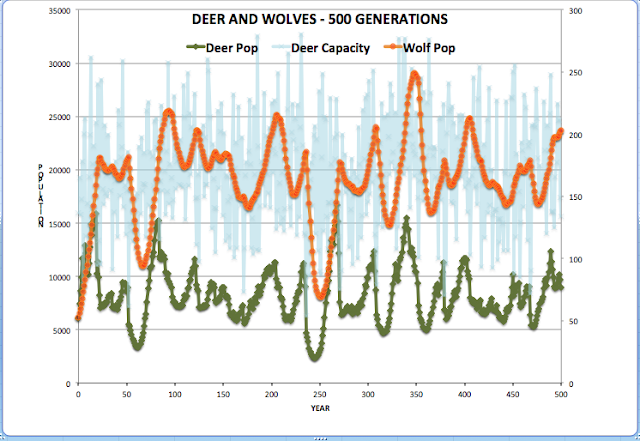What happens when predators are introduced? Will the deer herd die out sooner or will it stabilize because wolves keep the deer herd in check with the environment? Can predictions even be made? Let's see.
Scenario 1: Start with a deer herd well below the carrying capacity, a small number of wolves, and a constant environment.
The starting conditions are an initial deer population (N) of 5000, a growth rate (R) of 0.5(50% increase in deer herd per generation), carrying capacity (K) of 20000, no variance in the carrying capacity (KV=0), 5 wolves, a reproductive capacity of 0.1 (10%), and a predator efficiency (E) of 0.53 (53% - VERY good hunters), and a requirement (S) of 24 deer/wolf/year to sustain wolf pack growth.
Both the deer herd and wolf pack show rapid initial growth, followed by oscillations of population size, and finally a steady state based on the carrying capacity for the deer herd. The final steady state is well above the starting conditions for both deer and wolves and the final state for the deer is about half of the carrying capacity.
 |
| Predation in Stable Environmet |
Scenario 2: Add global warming or some other factor to make the environment variable
The variance for the carrying capacity has been increased from 0 to 1000, or a variance factor of 20% (100x1000/5000).
The oscillations in both deer and wolves has increased and no steady state is achieved although after 500 generations it does not appear that neither deer nor wolves are in danger of extinction.
 |
| Add Moderate Amount of Environmental Variability |
Scenario 3: Scenario 2 with more predation by increasing the wolf pack from an initial 5 to 50
Increasing the initial number of wolves from 5 to 50 does not change the overall dynamics. It would appear that starting with an initial wolf pack of fewer than what is sustainable has little long term effect. I leave it for the reader to try other starting wolf pack sizes once I have posted the interactive spreadsheet.
 |
| Increase Predation Pressure |
Scenario 4: Keep the starting wolf population at 50 and increase the environmental variability
Increasing the variance in carrying capacity to 100% dramatically shifts the oscillations in both the deer herd size and wolf pack numbers. While neither population crashes, they come perilously close. I leave it to the reader to try more simulations to see if the wolves, or deer, or both go to extinction under these conditions.
 |
| Increase Environmental Variability |
Scenario 5: Same as scenario 4 with initial carrying capacity cut in half
In this last scenario, the deer herd crashes and the wolves, lacking a food supply, follow.
 |
| Reduce Carrying Capacity |
Whether the wolves control the deer population or the deer control the wolf population is still an open question, but clearly the environment controls both. When the deer herd exceeds the carrying capacity of the environment extremes from one year to the next will ultimately result in a population crash. In the absence of predation, by this model, the deer herd will subsist only if the environment is very stable. If the environment is not stable (the normal course of events) predation pressure can help stabilize the deer herd by reducing the herd size and the odds that the deer herd will not exceed the carrying capacity are improved. Of course if the deer herd crashes so will the predators unless they have a reserve food source. That in fact is the case, but then it becomes a matter of energetics and whether switching to an alternative food supply for the predator is analogous to a drop in carrying capacity for the prey.
Next month I will post a link to the statistical model so that the reader can try some scenarios and draw their own conclusions.







